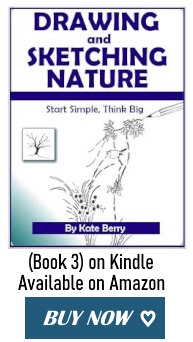Search for images or info
What are accent lines?
Accent lines in drawing are the equivalent of using accents in talking -- we put emphasis on certain words in conversation to place more importance on them and so that same theory applies in art, too.
It's not interesting to talk in a monotone and similarly just using one consistent line in a drawing makes it look uninteresting. So, to change that, all you need to do is use pressure on the pencil to accentuate areas where you want to make a statement.
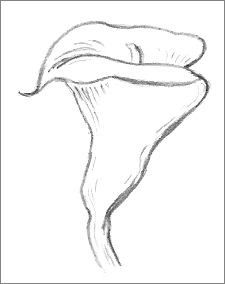
There are two basic guidelines for this technique:
- Accentuate lines nearest to you (everything is more distinct when close up).
- Accentuate only one side of an object and/or lines on the bottom (to represent shadow and weight).
Start off emphasising lines that you feel need something extra. It may not be (and doesn't have to be) the right place but this type of experimenting is excellent for your growth as an artist. You'll discover for yourself what you like and don't like or what looks right to you.
This quick sketch of a tree trunk demonstrates the simple use of an accent line and how it alters the visual outcome from mundane to something more alive.
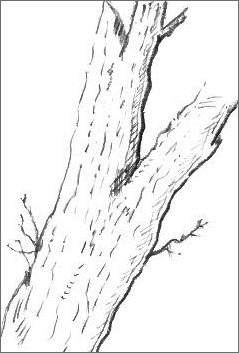
It's obvious the light source is coming from the left but there is nothing else in the image that signifies that. A statement was made with the single application of a heavier line. Pretty cool, hey?
Learn From Happy Accidents
Sometimes there are happy accidents like when I continuously drew over the exterior line for the glass sketch (below) to make it as straight as I could manage. I liked it dark so I left it like that because it could be interpreted to represent the thickness of the glass. The addition of a couple of other lines made the image appear to have more substance.
Categories
Sketches
Instruction
Freebies
Other Areas

** Disclaimer: I receive a small commission if you buy via my links -- at no extra cost to you. **
The How To Sketch Guide
Here's a book that finally dispels the mystery of sketching!
... it only takes a little instruction
or guidance... Read more >>
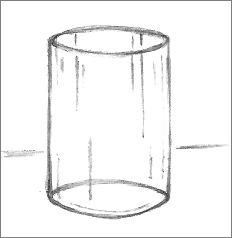
Rather than use a ruler, I like to create my own lines by lightly sketching them in with short, incremental strokes. (Drawing hard lines makes it harder to alter them.) I also turn the paper because it's easier for me to draw a horizontal line than a vertical one. I use the edge of the paper as a guide and I try to keep my line parallel with it. If I misjudge, that's ok, I'm wiser for the experience. It's not the best of drawings but it exists all in the name of practice.
So line accent is a very basic technique to apply. Now let's take that on to the next step which is to use this approach instead of normal shading methods.
Different Uses For Accent Lines
It takes some practice for trainee artists to fully understand how to shade every conceivable structure. The normal practice is to study using squares, circles and cylinders but if you're not ready for that yet, using accent lines will circumvent any stress and/or frustration.
You now have the option to use your intuition for the placement of shadow or shade detail.
Ok, so here's what you do... once you have a good outline, it's time to express your thoughts and feelings. Think about adding a few strategically placed strokes to represent shading as well as placing emphasis on a line or two.
Each extra stroke outside or inside an outline needs to have a meaning so apply them thoughtfully - mentally think of why a line is needed and add it once you're certain it belongs.
For example, imagine a leaf is folded over towards the tip. Just by adding some small strokes on the underside gives the viewer the impression of shadow falling on that area as well as the perception of a folded tip.
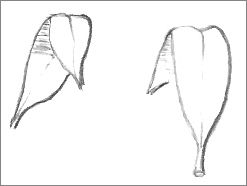
Every stroke has the important job of expressing a characteristic, however, I encourage you to exaggerate a line at any point just because you want to!
It may not be in the best place but if you are true to your thoughts and instincts, your best place will be found sooner rather than later. Being governed by rules is very restricting and this little technique can release the genius within you.
This is a great opportunity to see how far you can take a plain contour and make it into something special. Eventually, you will come to understand more about form and that will stand you in good stead forever.
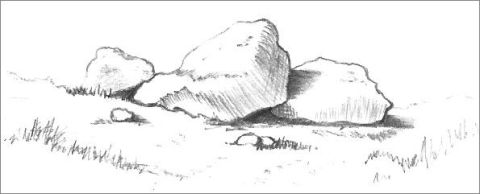
In the rock formation, I imagined where shade and shadow belonged. I visualized indents in the rocks so I added a few strokes to depict them in various places. Once the outline was formed, I didn't want a finished or detailed drawing so I only used simple accent lines as well as a crazy zigzag stroke to give the impression of grass.
I used a 2B pencil to create the outline and a 6B to achieve a darker tone for the shadow between rocks.
TIP: Be mindful of which direction the light comes from (light source) so that shadow always falls on the same side of things.
The shadowed shape doesn't have to be exact, just add in what you think it looks like. Who knows what exact shape a shadow should be? It's always different depending on time of day and all sorts of other variables so get out your artistic licence and have a blast with this!
I love this line accent technique because it encourages us to use our feelings when we draw. Also, it's not overwhelming, it's only a heavier line here or there as well as a couple of extra strokes to depict shading. Not every trial will be successful but since you should already be aware of that, you won't be disappointed.
The effort itself is necessary for you to learn and grow. Just remember that all problems can be overcome with a little patience and a healthy aspect towards experimentation.
Click a link below to view some different pencil techniques:
* Allaboutdrawings.com is a participant in the Amazon Services LLC Associates Program, an affiliate advertising program designed to provide a means for sites to earn advertising fees by advertising and linking to Amazon.com.
Copyright © 2005 - 2025 www.allaboutdrawings.com. All rights reserved.






